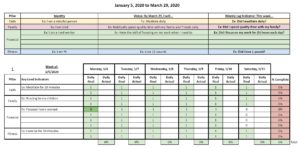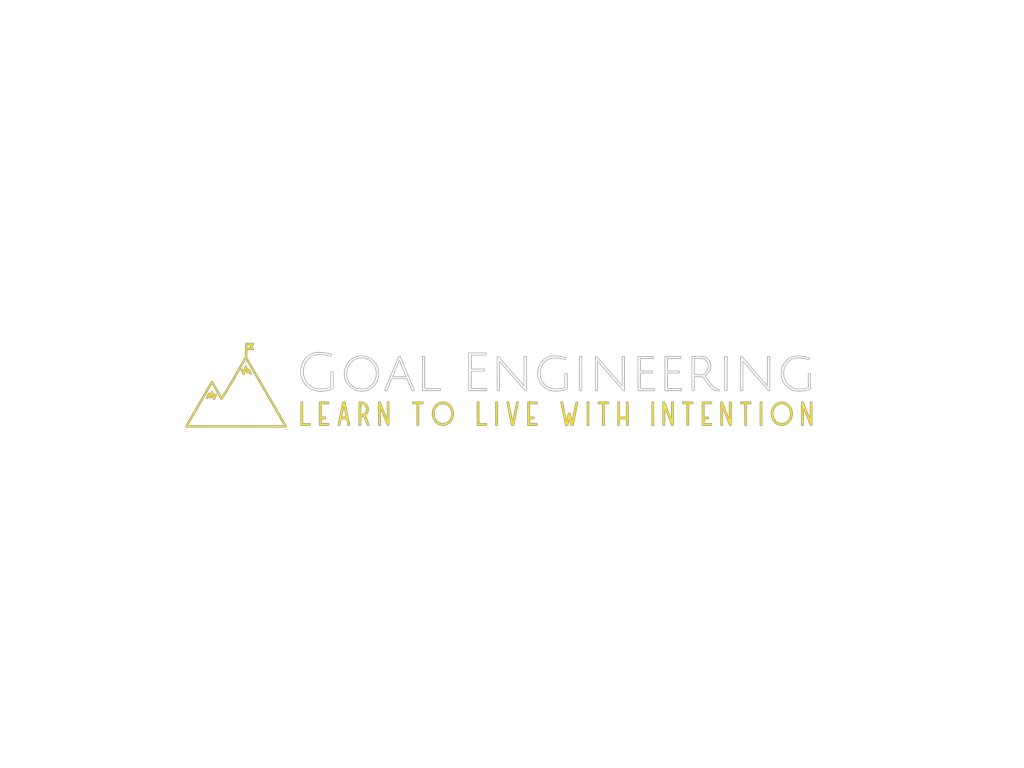Setting goals isn’t easy. You’ve probably failed so many times that you don’t even want to do it anymore. But this goal-setting how-to guide is going to change that.
A famous study by Harvard Business School identified the following numbers when it comes to people in the graduating class of 1979 who set goals:
- 84% had no goals.
- 13% had goals and a plan but nothing in writing.
- 3% of the class had written goals and have plans to achieve them.
After following up with these grads 10 years later, they found some informative but unsurprising results.
If you had been in the 13% of students who had a plan with your goals but not in writing, your income would be twice as much as the 84% that had no goals.
But consider how wealthy you’d be if you were in the 3% who wrote their goals and plans down. According to the study, they were making ten times more than the rest of the class.
You’re probably rolling your eyes right now because you’ve heard this hundreds of times. It sinks in every December and makes you consider improving your life in big ways once the new year starts.
And yet, each year you inevitably get tired of the work and lose steam by February only to repeat the cycle again the next year.
This is why you’re apprehensive about trying again. Is there any hope for you? For any of us to actually accomplish our aspirations?
I’m here to tell you that it’s not only possible but nearly inevitable if you’ll follow these few simple steps.
Although I was skeptical at times if any of this would solve my own problem with goals, I’ve now done it myself and I know these tools really work.
Goal-Setting How-To Step 1: Discovering your 4 Goals
Warren Buffett is one of the most successful and well-respected businessmen of our time. He is also exceptional at setting goals and gives us a great starting point for doing it ourselves.
His secret was the process he used for finding what he wanted to accomplish and honing in on only what was essential.
Buffett advocates what he refers to as the two-list method. Speaking with his long-time personal pilot, Mike Flint, Buffett told Flint to split his aspirations into two lists:
- List one was for the top 25 goals that would move him forward in his career.
- List two came from circling the 5 most important goals from list one.
After completing the second list, Buffett asked Flint what his plan was for the goals that were not in his top five. He replied by saying that he planned to work on those in his spare time.
Buffett’s response is the key to your success.
“No. You’ve got it wrong, Mike. Everything you didn’t circle just became your avoid-at-all-cost list. No matter what, these things get no attention from you until you’ve succeeded with your top 5.”
I want to help you get your own list of your five most important goals, but first, you need to understand what goals you should set.
The problem with your previous goal-setting patterns is that you’ve set too many. You get overwhelmed because you try to do too much and give up altogether.
It’s difficult to cut it down because you want to change so much about your life, but if you do it right, you’re going to succeed. Even where you haven’t before.
The 4 Pillars of Life
Although the method Warren Buffett uses for his goal-setting focused on his career, that’s just one aspect of your life, or pillar, as I like to call it.
But deep down, you know that you want the real fulfillment that comes from having good health, relationships, finances, and personal development, too.
These are the four pillars, or categories of life that everything you do falls into:
- Faith
- Family & Friends
- Finances
- Fitness
The word “pillars” is important because it identifies an important analogy for your life that’s helped me find balance.
When I do structural calculations for a house, I need to make sure that each beam has supports underneath it or it will fail.
Often, these are columns, another word for which is pillars. Imagine four columns supporting a structure, like this:

If I were to weaken or destroy one column by hitting it with a sledgehammer, for example, the other three would have to carry the weight that it used to be carrying.
And if the others didn’t have enough strength, the structure would fail and could hurt people when it does.
When all four are fully intact and strong, however, the building is safe and functional.
Your life is just like a building. The four pillars of faith, family, finances, and fitness support your happiness and success.
Each of these four might mean something different to you and that’s okay. Faith, for example, could be religious beliefs for one person and meditation to another. Fitness for me means both mental and physical health.
What’s important, though, is that each of these areas of your life is strong. When they are, you are at full capacity to live the life of your dreams. If just one is sagging, however, all the others struggle and so do you.
How to Get Your 4 Goals
If you wanted to do Buffett’s exact 25-goals method, you could. But we’re going to tweak it a little bit so that you have some balance and clarity with your goals. Here’s what you need to do:
- Write down your top 6 goals in each of the 4 categories. You’re going to have 24 goals in total. If you want to write more in one category, go ahead.
- Cross off less-important goals within each pillar until you have just one or two. To make it easiest, ask “Which one would make the biggest difference?” and “Which do I feel the most passionate about?”
Now that you’ve got your goals, let’s see how to break them down into smaller pieces that you can track so you can accomplish them!
Goal-Setting How-To Step 2: Tracking Your Goals by Going 4 Levels Deep With Them
By now you’ve written down what you want to accomplish. And I hate to break it to you but you’ve most likely actually set a plan and not a goal. But that’s okay!
We’re going to fix that and by doing so you’ll get some tools that will make you more likely to succeed at changing your life.
You need to turn them into actual goals now. We’re going to dive into the four levels of tracking your goals and you’ll see that yours fits into one of them already.
Then, I’ll show you how to break your goal down into the other levels in a bit. You’ll get the exact questions you need to ask yourself to divide it up into each of the levels for maximum effectiveness.
Let’s start by understanding why this step is so critical for success.
Kicking the Ball in Soccer Doesn’t Mean You’ll Score a Goal

In English, we often use the words “goal” and “plan” interchangeably. We say that we’ve set a goal when all we really have is a plan.
You can go four levels deep with goal-setting. The four goals that you’ve identified you want to work on falls into one of these levels:
- Level I: A Plan (Lead Indicator)
- Level II: A Goal (Lag Indicator)
- Level III: A Vision
- Level IV: An Identity Shift
So first, you set four goals and now you’re about to go four levels deep with them, is it making sense so far?
We’re going to dive into each of these with the example of “run 4x per week” as your health goal. To help us understand these better we’re going to compare them to soccer goals.
Level I: I have a goal to run 4x per week
This is not a goal, it’s a plan. Another word for it is a lead indicator. You’ll understand what that means in a moment.
Would a soccer player say their goal is to kick the ball 3x per minute? No, their goal is to put the ball into the net!
So why focus on this level? Whether or not we’re doing these actions INDICATES how likely a soccer player is to put the ball into the net, right?
If they kick the ball so many times a minute, or pass it so many times, or get it to point A then B then C down the field, we can have a pretty good idea if they’ll score or not.
That’s why it’s called a lead indicator. It’s leading out front, indicating whether or not you’re going to accomplish your actual goal.
Most of the time, you’ll want to track these steps daily but a weekly total can work too.
Level II: I have a goal to lose 12 pounds in 12 weeks
This is a true goal but isn’t the whole picture yet. We call this step a lag indicator. We’ll get to why in a second.
Here’s the big thing you don’t realize about this goal that is true of all other goals you set:
You can’t just go lose 12 pounds, you must complete other actions before you can achieve this outcome.
Can you score a goal in soccer first thing, without doing anything else first? No! Neither can you reach your desired result without action.
In other words, this desired result LAGS behind what you do, or your plan. It happens after you act. That’s also why the first level is known as a lead indicator.
This level you’ll track on weekly or monthly timelines usually because that’s when you can see an amount of progress worth tracking.
Let’s pause and recap for a moment.
At Level I, you have a plan, or lead indicator, that tells you the likelihood of reaching your goal.
Then at Level II, you have a goal, the result of which lags behind, so we call it a lag indicator.
In other words, you first run 3x per week and then at the end of the week step on the scale to see if you’ve lost that pound.
It sounds all fine and good, but if I was in the room with you right now I’d be asking you one more question:
What’s the purpose?
When you answer this question, you begin to discover the energy you can get from having even more powerful reasons for your goals.
Now let’s get into your deeper motivations for your goals so you can unlock the power of the deepest forms of motivation.
Level III: I want to get more stamina, or the ability to keep up physical or mental effort for a long period of time.
Now we’re getting to the good stuff. How do you find this out?
Ask yourself WHY you want to do whatever goal you’ve established in level 2.
We don’t do anything without a reason, and when you find the reasons for your actions, you unlock your deeper desires. You begin to tap into higher incentives.
In soccer, why do the players score goals? They each might have different reasons. Maybe they want to win or make lots of money.
The point is, you also have a deeper why for every goal you set. These desires you have tend to take longer, be bigger, and are tied to a skill or ability.
When you identify this level by asking yourself “why,” you also connect with the power of having a purpose. Your daily actions suddenly become part of a much bigger and more important picture.
As you begin to see the importance of your initial goal, your inspiration to keep going will grow.
You will want to track this on quarterly and yearly timelines. We’ll get to how to do that in a bit.
But you’re still not as deep as you can go. We’ve saved the best level for last.
Level IV: I want to become an athlete.
There’s one purpose for which a soccer player scores that I didn’t mention earlier. They make goals because they want to have the IDENTITY of a soccer player or a celebrity.
Identity is the deepest level of desire that you can have.
At your core, you want to become someone different, someone better, and you identify that with titles. It may be that you want to become a good husband and father. Or you could aim for becoming a CEO.
This level is all about becoming, in case you can’t tell already.
How do you discover this? Two questions to ask yourself:
- Why do I want to accomplish my level III goal?
- Who do I want to become in regards to my faith, family, finances, and fitness?
Now that we know the four levels of goals, we can begin to break yours down within all of these so that you can start accomplishing them.
Breaking Your Goal Down Step by Step

How do you eat an elephant?
One bite at a time.
You need to do the same with your goals, and now I’m going to show you how.
I know that what I just taught you was a lot and now I want to just recap in simpler terms and bullet points so you can easily follow along step-by-step to get your goals into bite-sized pieces.
Remember, your current goal already fits into only one of these four levels. You’ll need to do some exploring to figure out how to get all four levels of depth to unlock the powers of tracking, accountability, and motivation.
Level I: Plan (Lead Indicator)
What is it? How you plan to accomplish your goal, including the daily or weekly steps you will take to achieve it.
When do you track it? Daily or weekly.
Examples: Read for 30 minutes a day, spend 2 hours of quality time with the kids each day, run 4 times per week.
Level II: Goal (Lag Indicator)
What is it? The actual goal that you want to accomplish, the results of which lag behind your daily or weekly actions.
When do you track it? Weekly or monthly.
Examples: I finished one book this week, I became closer to my spouse and kids, I made $2,000 this week.
Level III: Vision
What is it? The future that you envision for yourself.
When do you track it? Quarterly or yearly.
Examples: I am best friends with my spouse and children, I make $100,000 a year, I have a six-pack and stamina.
Level IV: Identity
What is it? Who you are going to become by working toward this goal.
When do you track it? Yearly or more long-term.
Examples: I am an intelligent person, I am a kind and patient husband and father, I am a blogger, I am an athlete.
Now, to make it even easier, here’s an outline of what to ask yourself to get to the other levels depending on where the goal you identified with Warren Buffett’s two list method falls:
If your initial goal was at Level I:
- Get to Level II: What outcome do I want from those actions?
- Get to Level III: Why do I want that outcome?
- Get to Level IV: Who do I want to become by doing these things? What part of my identity will this help me grow?
If your initial goal was at Level II:
- Get to Level I: What daily or weekly steps can I take to achieve it?
- Get to Level III: Why do I want that outcome?
- Get to Level IV: Who do I want to become by doing these things? What part of my identity will this help me grow?
If your initial goal was at Level III:
- Get to Level II: What weekly outcomes would lead to this?
- Get to Level I: What daily actions will make those outcomes happen?
- Get to Level IV: Who do I want to become by doing these things? What part of my identity will this help me grow?
If your initial goal was at Level IV:
- Get to Level III: What do I need to accomplish by the next quarter to achieve this desired identity change? What about the quarter after that? Continue until you have a long-term plan.
- Get to Level II: What weekly steps are necessary to achieve my quarterly goal?
- Get to Level I: What daily steps must I take to accomplish my weekly goals?
Goal-Setting How-To Step 3: Establishing Consistency by Tracking Your Goals Over 4 Quarters Instead of Yearly
What’s the status of the goals that you set in December? Or, if you’re reading this in December, how likely do you think you’ll have given up by January?
You’re probably disillusioned with goal-setting because the same pattern emerges each year:
- You want to change your life, so you make some big plans in December or January.
- The new year begins with a fresh perspective and motivation and you hit the gym and read daily and accomplish all of your goals.
- It gets tough and by February you’ve given up or made the excuse that you still have time in the year to accomplish them “someday.”
- July rolls around and you realize that you haven’t done anything yet but also believe there is plenty of time left in the year to still do them.
- Before you know it, it’s November again and you throw in the towel and say you’ll start again next year.
Rinse and repeat for years and you have the answer to why you’ve stopped setting goals. Or have a hard time believing you’ll ever accomplish the ones you do set.
I know you’ve struggled in the past, but just try this one last thing and I promise it will change your life forever. I know because it changed mine.
How One Idea Got Me Back on Track After a Big Failure
In February of 2019, I lost the first job I’d had out of college. Suddenly, I was struggling to focus on and achieve my goals. I longed for some semblance of organization as I attempted to navigate self-employment.
That’s when I discovered The 12-Week Year.
The authors explain how yearly goal-setting is a recipe for disaster for the reasons I’ve mentioned above. But when you track your goals on 12-week cycles, everything improves.
Suddenly you have four chances to start over each year with all the new motivation and enthusiasm that you get each January. Plus you never have to make excuses to put off your goals because another cycle is always just around the corner!
After applying this quarterly-goal-setting pattern to my system, I quickly lost 10 pounds, doubled my income, and got into better habits of spending quality time with my family.
It made goal-setting way easier and best of all unlocked the power of accountability.
You can get access to the system I built around it by clicking here.
Here’s a sneak peek of it:

It’s a system that will give you a place to monitor your longer-term identity and vision for your life, track those with quarterly goals, and break those down further into weekly and daily indicators for success.
Let’s Wrap This Up So You Can Get Goal-Setting!
How does it feel to know that you are now an expert at goal-setting?!
You’ve got your four goals to enable you to stay balanced and avoid getting overwhelmed.
You know how to go four levels deep with them to unlock the power of your deepest motivations and desires.
You’re ready to start tracking them on a four quarters per year schedule instead of yearly to utilize the potential in regular accountability.
And below, you can get access to my custom-made spreadsheet that will give you a place to input and work on all of your goals with this system as part of the Goal Engineering Starter Kit.
I’m confident that with these steps, you’re going to find yourself accomplishing your most exciting dreams and more in no time!
If you want to talk goals or let me know how yours are going, feel free to shoot me a message at luke@goalengineer.com. I would love to hear from you!
Good luck and happy goal-setting!





